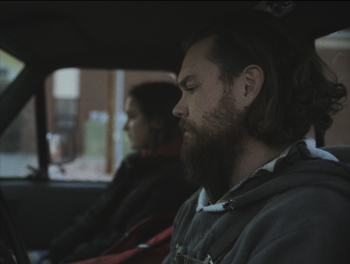


Machaoian reverse-engineers a story that blasts out of the gate with purpose, establishing violent intents in the opening scene (and, again, that title) that aren’t carried through, but, no matter how calm and ordinary the rest of the movie may be, the underlying tension remains, and the audience’s anxiety is maintained, creating a visceral, organic and ultimately claustrophobic experience that is hypnotic and, ultimately, savagely satisfying.
The Killing of Two Lovers tells a very simple story of a young married couple, David and Nikki (Clayne Crawford and Sepideh Moafi), who have recently separated but still have an amicable relationship while they continue to care for their four young children. Even though they have agreed that it’s ok to see other people while they each take the time and space they need to see if the marriage can be salvaged, David is having a difficult time accepting both the separation and the fact that Nikki is actually seeing another man. His quiet, calm and internal demeanor belie the rage that bubbles inside, as David becomes obsessed with Nikki’s boyfriend, played by Chris Coy, and follows him around town and even seeks out to confront him, in a moment that serves as a powerful climax that releases all the tension building up to it.
Machoian’s purposeful igniting of the fuse in the first scene that then continues to slow burn through the next two hours, finally blowing up in the final moments, is a masterful piece of film-making. The afore-mentioned anxiety that builds for the audience is coupled with a quiet and rather ordinary slice-of-life, almost mundane journey with David through the course of his day, eating lunch, working, driving. As in real life, bursts of excitement are surrounded by long periods of nothing much happening, and yet those few moments of drama are what we all obsess over during those long periods of quiet that surround them. Crawford is riveting as a man who has been forced into circumstances he does not want, but knows that the only way to get his family back is to be calm and play by the rules, even though it is killing him inside. Crawford finds every nuance in his quiet performance as a man who toggles between rage, confusion and sadness, lost in a limbo of desperation, coming achingly close to the breaking point. It’s impossible, in this day and age, to not imagine David as someone who could “snap,” and Machoian certainly plays with the audience’s built-in anxiety of what we have seen all too many times when a man becomes just unhinged and desperate enough.
The nuanced and quietly powerful performances are enhanced by Machoian’s and cinematographer Oscar Ignacio Jiménez’s stark and colorless photography, as the film is set in an unnamed middle-American small town in the dead of winter and the isolation and coldness of the setting serve as perfect companions to David’s desperation and hopelessness, as does the discordant score, which triggers those butterflies in our stomach as we sense dread approaching.
And yet this film is exceedingly natural and organic, which is perhaps Machoian’s greatest achievement. David is a good father, as we see him with his children, and Machoian purposely presents mundane family moments to underscore the normality of it all. The interactions between David and Nikki feel relatable and real, two people just trying to figure it out. Most of the scenes are lived-in, mundane, regular life moments, the last place you would expect a psychological thriller to be played out. And yet, a thriller is still finds a way to be. The Killing of Two Lovers is a slow burn built on tension and character that will draw you in, climaxing in the least expected way.
Originally published on Awards Watch.
